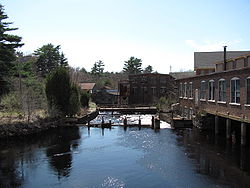
The Satucket River is 5.5-mile-long (8.9 km)[1] river in southeastern Massachusetts within the Taunton River Watershed. It flows generally west from Robbins Pond in East Bridgewater, and into the Matfield River.

The Satucket River drains a watershed of 34.9 square miles and 700 acres of natural ponds."Satucket River, East Bridgewater Mass. Fish Passage and Boating Improvement Project".[2] It includes parts of Abington, Whitman, Hanson, East Bridgewater and Halifax. The river is rich with iron and has a tint the color of tea. It’s generally slow moving water and relatively shallow, no more than 8 feet deep even in its deepest spots. It’s fed by the Poor Meadow Brook that takes in the flow of the Shumatuscacant River which drains into Abington and Whitman. Poor Meadow Brook then joins the Satucket just below Robbins Pond in East Bridgewater."Satucket River, below Robins Pond in East Bridgewater".[3] Robbins Pond, which is another body of water in East Bridgewater, is a 124 acre natural warm water pond. Its predominantly sandy bottom has a fairly uniform 6 foot depth. The pond is mostly still water however it does drain into the Satucket."Robbins Pond, East Bridgewater, Plymouth County, Taunton River Watershed".[4] Located above Robbins Pond is Stump Brook, which drains through Halifax from Monponsett Pond, a 528 acre pond to form Robbins Pond which turns into the Satucket River at its outlet.
The Satucket River is a very winding river, it never freezes in the winter and is unmaintained which results in many fallen trees, which clog the river and make it hard for the river to be a means of travel. It’s undammed now but had one working dam in the past, provided by the Murray Carver Mill. This small dam co-existed with a water wheel and generated electricity to power the cotton gin. As a result of the unused dam 4.4 miles of the Satucket River up to Robbins Pond are unreachable by the once common river herring and other fish and the river and pond serve as suitable environments for these fish to swim up and spawn."Managing Massachusetts’ River Herring Fishery, Restoring a Historic Source of Plenty".[5]